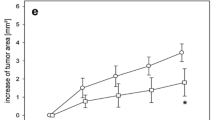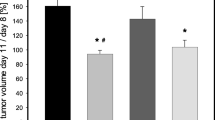Abstract
Liver failure after extended hepatectomy represents a major challenge in the surgery of hepatic colorectal metastasis. A previous study has indicated that inhibition of phosphodiesterase type 3 (PDE 3) stimulates liver regeneration. However, little is known whether PDE 3 inhibitors, such as cilostazol, also stimulate the growth of remnant metastases. Therefore, we herein studied the effect of cilostazol on engraftment, vascularization and growth of colorectal liver metastasis after major hepatectomy. WAG-rats underwent either major hepatectomy or sham operation. Metastases were induced by subcapsular implantation of 5 × 105 CC531-colorectal cancer cells. Animals were daily treated with cilostazol (5 mg/kg body weight) or glucose solution. Tumor growth was measured by high-resolution ultrasound at days 7 and 14. Tumor vascularization and tumor cell proliferation were determined by immunohistochemistry and western blotting. High-resolution ultrasound analysis in hepatectomized and non-hepatectomized animals showed that cilostazol does not stimulate tumor growth. Accordingly, the number of PCNA-positive tumor cells did not differ between cilostazol-treated animals and sham-treated controls. Interestingly, cilostazol reduced tumor vascularization in both hepatectomized and non-hepatectomized animals. This was indicated by a significantly lower number of platelet-endothelial cell adhesion molecule (PECAM-1)-positive cells in tumors of cilostazol-treated animals compared to sham-treated controls. The PDE 3 inhibitor cilostazol does not stimulate the growth of colorectal metastases during liver regeneration after major hepatectomy.






Similar content being viewed by others
References
Siegel R, Naishadham D, Jemal A (2012) Cancer statistics, 2012. CA Cancer J Clin 62:10–29
Taylor I (1996) Liver metastases from colorectal cancer: lessons from past and present clinical studies. Br J Surg 83:456–460
Morris EJA, Forman D, Thomas JD et al (2010) Surgical management and outcomes of colorectal cancer liver metastases. Br J Surg 97:1110–1118
Rees M, Tekkis PP, Welsh FKS, O’Rourke T, John TG (2008) Evaluation of long-term survival after hepatic resection for metastatic colorectal cancer: a multifactorial model of 929 patients. Ann Surg 247:125–135
Nordlinger B, Sorbye H, Glimelius B et al (2008) Perioperative chemotherapy with FOLFOX4 and surgery versus surgery alone for resectable liver metastases from colorectal cancer (EORTC Intergroup trial 40983): a randomised controlled trial. Lancet 371:1007–1016
Vauthey JN, Pawlik TM, Ribero D et al (2006) Chemotherapy regimen predicts steatohepatitis and an increase in 90-day mortality after surgery for hepatic colorectal metastases. J Clin Oncol 24:2065–2072
Gomez D, Malik HZ, Bonney GK, Wong V, Toogood GJ, Lodge JPA, Prasad KR (2007) Steatosis predicts postoperative morbidity following hepatic resection for colorectal metastasis. Br J Surg 94:1395–1402
Hemming AW, Reed AI, Howard RJ et al (2003) Preoperative portal vein embolization for extended hepatectomy. Ann Surg 237:686–693
Wicherts DA, Miller R, de Haas RJ et al (2008) Long-term results of two-stage hepatectomy for irresectable colorectal cancer liver metastases. Ann Surg 248:994–1005
Primrose JN (2010) Surgery for colorectal liver metastases. Br J Cancer 102:1313–1318
Nishino M, Iimuro Y, Ueki T, Hirano T, Fujimoto J (2008) Hepatocyte growth factor improves survival after partial hepatectomy in cirrhotic rats suppressing apoptosis of hepatocytes. Surgery 144:374–384
Schmeding M, Boas-Knoop S, Lippert S et al (2008) Erythropoietin promotes hepatic regeneration after extended liver resection in rats. J Gastroenterol Hepatol 23:1125–1131
Akcan A, Kucuk C, Ok E, Canoz O, Muhtaroglu S, Yilmaz N, Yilmaz Z (2006) The effect of amrinone on liver regeneration in experimental hepatic resection model. J Surg Res 130:66–72
Sunagawa M, Shimada S, Hanashiro K, Nakamura M, Kosugi T (2006) Elevation of intracellular cAMP up-regulated thrombomodulin mRNA in cultured vascular endothelial cells derived from spontaneous type-II diabetes mellitus model rat. Endothelium 13:325–333
Ikegami T, Nishizaki T, Hiroshige S, Ohta R, Yanaga K, Sugimachi K (2001) Experimental study of a type 3 phosphodiesterase inhibitor on liver graft function. Br J Surg 88:59–64
Saito S, Hata K, Iwaisako K, Yanagida A, Takeiri M, Tanaka H, Kageyama S, Hirao H, Ikeda K, Asagiri M, Uemoto S (2014) Cilostazol attenuates hepatic stellate cell activation and protects mice against carbon tetrachloride-induced liver fibrosis. Hepatol Res 44:460–473
Sill JC, Bertha B, Berger I, Uhl C, Nugent M, Folts J (1997) Human platelet Ca2+ mobilization, glycoprotein IIb/IIIa activation, and experimental coronary thrombosis in vivo in dogs are all inhibited by the inotropic agent amrinone. Circulation 96:1647–1653
Ogawa S, Koga S, Kuwabara K, Brett J, Morrow B, Morris SA, Bilezikian JP, Silverstein SC, Stern D (1992) Hypoxia-induced increased permeability of endothelial monolayers occurs through lowering of cellular cAMP levels. Am J Physiol 262:546–554
Dold S, von Heesen M, Müller S, Kollmar O, Schilling MK, Menger MD, Moussavian MR (2011) Effect of Cilostazol® on hepatic microcirculation and liver regeneration after partial hepatectomy in a rat model. Langenbecks Arch Surg 396:581 (abstract)
Mizutani J, Hiraoka T, Yamashita R, Miyauchi Y (1992) Promotion of hepatic metastases by liver resection in the rat. Br J Cancer 65:794–797
Slooter GD, Marquet RL, Jeekel J, Ijzermans JN (1995) Tumour growth stimulation after partial hepatectomy can be reduced by treatment with tumour necrosis factor alpha. Br J Surg 82:129–132
Drixler TA, Borel Rinkes IH, Ritchie ED, van Vroonhoven TJ, Gebbink MF, Voest EE (2000) Continuous administration of angiostatin inhibits accelerated growth of colorectal liver metastases after partial hepatectomy. Cancer Res 60:1761–1765
Picardo A, Karpoff HM, Ng B, Lee J, Brennan MF, Fong Y (1998) Partial hepatectomy accelerates local tumor growth: potential roles of local cytokine activation. Surgery 124:57–64
Harun N, Nikfarjam M, Muralidharan V, Christophie C (2007) Liver regeneration stimulates tumor metastases. J Surg Res 138:284–290
Martins PNA, Theruvath TP, Neuhaus P (2008) Rodent models of partial hepatectomies. Liver Int 28:3–11
Kollmar O, Schilling MK, Menger MD (2004) Experimental liver metastasis: standards for local cell implantation to study isolated tumor growth in mice. Clin Exp Metastasis 21:453–460
Laschke MW, Körbel C, Rudzitis-Auth J et al (2010) High-resolution ultrasound imaging. Am J Pathol 176:585–593
Nguyen L, Fifis T, Malcontenti-Wilson C, Chan LS, Costa PN, Nikfarjam M, Muralidharan V, Christophi C (2012) Spatial morphological and molecular differences within solid tumors may contribute to the failure of vascular disruptive agent treatments. BMC Cancer 12:522
Sperling J, Brandhorst D, Schäfer T et al (2013) Liver-directed chemotherapy of cetuximab and bevacizumab in combination with oxaliplatin is more effective to inhibit tumor growth of CC531 colorectal rat liver metastases than systemic chemotherapy. Clin Exp Metastasis 30:447–455
Nakamura T, Houchi H, Minami A et al (2001) Endothelium-dependent relaxation by cilostazol, a phosphodiesteras III inhibitor, on rat thoracic aorta. Life Sci 69:1709–1715
Weintraub WS (2006) The vascular effects of cilostazol. Can J Cardiol 22:56–60
Lee TM, Su SF, Tsai CH, Lee YT, Wang SS (2001) Differential effects of cilostazol and pentoxifylline on vascular endothelial growth factor in patients with intermittent claudication. Clin Sci 101:305–311
Geng D, Deng J, Jin D, Wu W, Wang J (2012) Effect of cilostazol on the progression of carotid intima-media thickness: a meta-analysis of randomized controlled trials. Atherosclerosis 220:177–183
Friedland SN, Eisenberg MJ, Shimony A (2012) Meta-analysis of randomized controlled trials on effect of cilostazol on restenosis rates and outcomes after percutaneous coronary intervention. Am J Cardiol 109:1397–1404
Kim JE, Sung JY, Woo CH et al (2011) Cilostazol inhibits vascular smooth muscle cell proliferation and reactive oxygen species production through activation of AMP-activated protein kinase induced by heme oxygenase-1. Korean J Physiol Pharmacol 15:203–210
Muñoz B, Huerta M, López-Bayghen E (2009) Cilostazol reduces proliferation through c-Myc down-regulation in MDCK cells. Eur J Pharmacol 616:22–30
Murata K, Kameyama M, Fukui F et al (1999) Phosphodiesterase type III inhibitor, cilostazol, inhibits colon cancer cell motility. Clin Exp Metastasis 17:525–530
Ikeda Y, Matsumata T, Takenaka K, Yamagata M, Sugimachi K (1998) Effects of doxorubicin and/or cilostazol on cancer cells during liver regeneration after two-thirds hepatectomy in rats. Oncology 55:354–356
Mendes JB, Campos PP, Rocha MA, Andrade SP (2009) Cilostazol and pentoxifylline decrease angiogenesis, inflammation, and fibrosis in sponge-induced intraperitoneal adhesion in mice. Life Sci 84:537–543
Wang F, Li M, Cheng L et al (2008) Intervention with cilostazol attenuates renal inflammation in streptozotocin-induced diabetic rats. Life Sci 83:828–835
Biscetti F, Pecorini G, Straface G et al (2013) Cilostazol promotes angiogenesis after peripheral ischemia through a VEGF-dependent mechanism. Int J Cardiol 167:910–916
Chao TH, Tseng SY, Li YH et al (2012) A novel vasculo-angiogenic effect of cilostazol mediated by cross-talk between multiple signalling pathways including the ERK/p38 MAPK signalling transduction cascade. Clin Sci 123:147–159
Shin HK, Lee HR, Lee DH et al (2010) Cilostazol enhances neovascularization in the mouse hippocampus after transient forebrain ischemia. J Neurosci Res 88:2228–2238
Rajesh L, Joshi K, Bhalla V, Dey P, Radotra BD, Nijhawan R (2004) Correlation between VEGF expression and angiogenesis in breast carcinoma. Anal Quant Cytol Histol 26:105–108
Wechsel HW, Feil G, Bichler KH, Beiter T, Gleichmann R (2000) Serologic angiogenesis factors and microvascular density in renal cell carcinoma: two independent parameters. Anticancer Res 20:5117–5120
Amirkhosravi A, Meyer T, Warnes G et al (1998) Pentoxifylline inhibits hypoxia-induced upregulation of tumor cell tissue factor and vascular endothelial growth factor. Thromb Haemost 80:598–602
Netherton SJ, Maurice DH (2005) Vascular endothelial cell cyclic nucleotide phosphodiesterases and regulated cell migration: implications in angiogenesis. Mol Pharmacol 67:263–272
Hayashi H, Sudo T (2009) Effects of the cAMP-elevating agents cilostamide, cilostazol and forskolin on the phosphorylation of Akt and GSK-3beta in platelets. Thromb Haemost 102:327–335
D’Angelo G, Lee H, Weiner RI (1997) cAMP-dependent protein kinase inhibits the mitogenic action of vascular endothelial growth factor and fibroblast growth factor in capillary endothelial cells by blocking Raf activation. J Cell Biochem 67:353–366
Lee JH, Kim KY, Lee Y-K et al (2003) Cilostazol prevents focal cerebral ischemic injury by enhancing casein kinase 2 phosphorylation and suppression of phosphatase and tensin homolog deleted from chromosome 10 phosphorylation in rats. J Pharmacol Exp Ther 308:896–903
Santos M, Celotto AC, Capellini VK et al (2012) The protective effect of cilostazol on isolated rabbit femoral arteries under conditions of ischemia and reperfusion: the role of the nitric oxide pathway. Clinics 67:171–178
Sprague RS, Bowles EA, Achilleus D, Stephenson AH, Ellis CG, Ellsworth ML (2011) A selective phosphodiesterase 3 inhibitor rescues low PO2-induced ATP release from erythrocytes of humans with type 2 diabetes: implication for vascular control. Am J Physiol Heart Circ Physiol 301:2466–2472
Acknowledgments
This study was supported by a HOMFOR 2010 grant (T201000614) of the Medical Faculty of the Saarland University. We appreciate the excellent technical assistance of Janine Becker and Christina Marx.
Conflict of interest
There is no conflict of interest of any of the authors.
Author information
Authors and Affiliations
Corresponding author
Additional information
Moritz J. Strowitzki and Stefan Dold have contributed equally to this work.
Rights and permissions
About this article
Cite this article
Strowitzki, M.J., Dold, S., von Heesen, M. et al. The phosphodiesterase 3 inhibitor cilostazol does not stimulate growth of colorectal liver metastases after major hepatectomy. Clin Exp Metastasis 31, 795–803 (2014). https://doi.org/10.1007/s10585-014-9669-y
Received:
Accepted:
Published:
Issue Date:
DOI: https://doi.org/10.1007/s10585-014-9669-y




